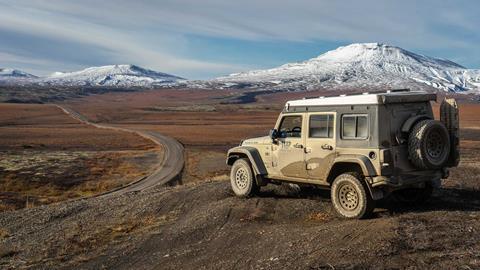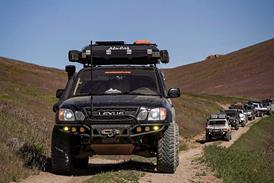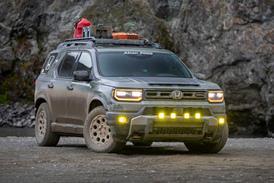All across North America, oversize tires are now seen as an essential upgrade on any four-wheel-drive vehicle, even those built for overlanding. Just a few years ago 35-inch tires were considered large, and now 37s are run-of-the-mill for most off-roaders.
Even 40-inch tires are not uncommon, and it seems the constant growth may never stop. It might just be that “bigger is better” has never applied to anything as well as it does to tire sizes on four-wheel-drives in North America.
As soon as that vehicle ventures outside North America, however, the situation changes dramatically. One look at global overlanders and it quickly becomes clear that tires that large are rarely seen.

In stark contrast to North America, for those exploring continents or the entirety of the globe the suggestion of monster tires is quickly dismissed, and most make do with stock 31- or 32-inch tires. There are myriad of reasons for this clear difference, and it turns out that many of the practical reasons also apply to a vehicle built to explore the far corners of North America.
Big Tires Are Cool
Upgrading to larger tires certainly comes with benefits, and for the sake of completeness, let’s put them on the table now. First and foremost, tires with a larger diameter increase the height of the vehicle and specifically increase ground clearance, making the vehicle more capable of clearing obstacles on the trail.
All other things being equal, upgrading from 33-inch tires to 37-inch tires will add two inches of clearance under the vehicle (the other two inches of difference between 33 and 37 essentially wind up above the axle, filling up the guards).

Secondly, larger diameter tires most often have a wider tread patch. While 33s are commonly 11 inches wide, 35s and 37s are most commonly 12.5 inches wide. That extra inch and a half per tire vastly increases the size of the tire’s contact patch, increasing grip in low-traction situations. When these tires are aired down, the contact patch is enormous and traction improves dramatically.
Of course, filling up the guards and raising the vehicle to sit a little taller also looks cool, if you’re into that kind of thing. Undeniably, big tires are cool and they increase the capability of a given vehicle. With larger tires a vehicle will be able to clear bigger obstacles and find more traction in slippery situations. Without a doubt, that vehicle will be able successfully navigate more difficult terrain, which is a huge improvement if that’s what you’re going for.
What we don’t hear about very often, however, are the downsides of upgrading to larger tires.
It All Comes At a Cost
Even before we think about a global overlanding trip, there are a number of downsides associated with running larger tires that should be carefully considered. First and foremost of these is the cost. Not only do larger tires cost more themselves; they virtually always require a slew of expensive upgrades to be completed on the vehicle so that it will still drive and handle correctly.

New wheels with a bigger offset will be required so the wider tires are pushed farther out from the center of the vehicle. This ensures the inside of the tire will not rub on steering and suspension components, especially at full steering lock when the suspension is at maximum up-travel.
To compensate for the different rolling diameter, front and rear axles will need to be re-geared to help the engine turn the wheels at the appropriate speed and to keep the engine in the optimum power and torque bands.
Depending on the vehicle and tires being considered, it’s also likely axles will need to be strengthened or completely upgraded—either when the large tires are added, or when the diffs are catastrophically torn apart by the extra forces they were never designed to handle.
With extra-large tires hydro-assist steering is often required, simply to make it possible to turn the steering wheel.
Finally, almost all vehicles will require upgrades to numerous suspension components so the larger tires will not scrub on the inside of the guards and to limit suspension up and down travel in a range that is appropriate for the larger tires.

The added weight of larger tires and degraded aerodynamics due to the vehicle sitting higher mean the engine will be working harder for each tire revolution, which results in higher fuel consumption. While a couple of miles per gallon of extra fuel consumption might not be a big deal for a weekend at the local off-road park, on a 15,000-mile round trip to the Arctic Ocean that could add an extra $700 to the fuel bill for a vehicle that drops from 16 to 14 mpg because of the larger tires.
All of those expenses quickly add up, and when all is said and done, a six-month trip to Alaska and back in a vehicle with stock tires will be cheaper than all of the upgrades listed above. For those passionate about exploring the world in their own four-wheel-drive vehicle, the choice between more gear and bling or a lifetime of experiences is an easy one to make.
Wear and Tear
Not only do larger tires cost more up front, they also increase long-term expenses by putting more wear and tear on steering and suspension components. With an increase in unsprung weight and more force on components like tie rods, ball joints, and wheel bearings, service intervals need to be reduced to compensate.
With those components under more stress than they were ever designed for, failures also become more common. We need only to look at all the Jeep Wranglers with broken axles to see the impact larger tires has on long-term reliability.
With smaller tires, axles and steering components are well within design limits, and rarely, if ever, fail. Once 37-incha tires are part of the equation, however, it’s just a matter of time before a serious component failure occurs.
While a replacement axle might not be a big deal if you’re outside Moab, Utah, it is a very serious problem in the remote corners of Africa or South America.

While larger tires undoubtedly provide more traction, which is commonly thought to be a good thing, it can actually be a bad thing. The enormous contact patch of large tires can provide almost unlimited grip, which means wheel spin is no longer the weakest link in the driveline. With modern engines producing plenty of power and torque, some component between the flywheel and tire will inevitably break.
On the other hand, while running smaller stock tires, grip will be the weakest link, and tires will spin and slip long before anything breaks. While I might not win any style points for needing to winch over a relatively easy obstacle, I always prefer to break traction before breaking anything else.
This becomes more and more true the further from home and easy parts support we decide to explore.
Global Considerations
Once an overlander leaves North America, all the above complications are further compounded and only become more of a problem. During my 54,000-mile expedition around Africa on 33-inch tires, I spent roughly $18,000 on gas alone.

I shudder to think how high that number would have been if I was running 37-inch rubber. In all honesty, I simply would not have been able to afford the adventure at all. Higher fuel consumption would also have meant I would have had to carry more fuel for a given range. Fuel is heavy, and carrying more fuel means carrying fewer essentials like drinking water and food.
In the Congo I pushed the limits of my range during a country-wide gas shortage, covering more than 670 miles between stations while sipping fuel at 20 mpg. Had my vehicle been burning 16 mpg, I wouldn’t have made it. Due to the severe shortages, I was only able to scrounge up a limited amount of gas in the capital city, and again I’m not sure the expedition would have been possible if I had needed more gas.
While it sounds like a minor inconvenience, running wider tires that stick out past the guards often results in mud being thrown down the side of the vehicle. This is fun on a day trip and a mark of pride for a weekend out with friends, but when that vehicle is your full-time home it’s downright annoying.

Each and every day you will be in and out of the vehicle to get clothes, cook, brush your teeth, and move your bedding around. Before long everything you own is covered in mud, and the whole trip becomes a lot less enjoyable to the point you simply won’t want to continue.
Another issue with large tires around the world is the availability of those oversize tires. While 35- and 37-inch tires are commonly available all across North America, they are virtually non-existent in the rest of the world.
If a damaged tire needs to be replaced, sourcing even a single tire is next to impossible in many countries, in part because nobody uses them locally so stores will not stock them, but also because tire upgrades that large are illegal in many countries.

And that brings us to the final nail in the coffin for using oversize tires on a global expedition—the legality. While stubby bumpers, six-inch suspension lifts, and tires sticking well outside guards are a common sight in North America, they are highly illegal across Europe, Australia and many other parts of the world.
Due to pedestrian safety laws, vehicles modified in this way will be put off the road immediately, putting an end to any expedition before it can even get underway.
Bigger Is Not Always Better
Rather than focusing purely on the size of tires, global overlanders often prefer to focus on quality brand-name tires. Roads like the Dempster Highway to the Arctic Ocean, Route 40 to Southern Argentina, and the Gibb River Road in Australia are notorious for shredding no-name tires of lesser quality.
When purchasing tires well-known brand names are more expensive, but there’s no doubt you get what you pay for. And when you’re tens of thousands of miles from home, quality is more important than size every day of the week.

So, while larger tires give an extra inch or two of ground clearance under the lowest and most vulnerable part of the vehicle—typically the differential pumpkin—the list of downsides is considerable. There’s no doubt big tires look great, and more power to you if that’s your priority.
As I continue to explore the world one continent at a time my priorities are clear. Practicality, cost, and long-term vehicle reliability are far, far more important than looks or an extra inch of clearance under the pumpkin.
Final Thoughts
While modest tire sizes might not give enough clearance for the hardest trails in Moab, they’re absolutely ideal for exploring Alaska or any other long-distance overland destination on the planet. From personal experience I can confidently say 33-inch tires are perfectly adequate to explore the wild and remote corners of Central and South America, Africa and Australia.
I’m often asked when I’ll be upgrading to 37s, and my answer is always the same.
Not in a million years.
Access More Great Stories!
This article originally appeared in OVR Issue 04. For more informative articles like this, consider subscribing to OVR Magazine in print or digital versions here. You can also find the print edition of OVR at your local newsstand by using our Magazine Finder.





















No comments yet